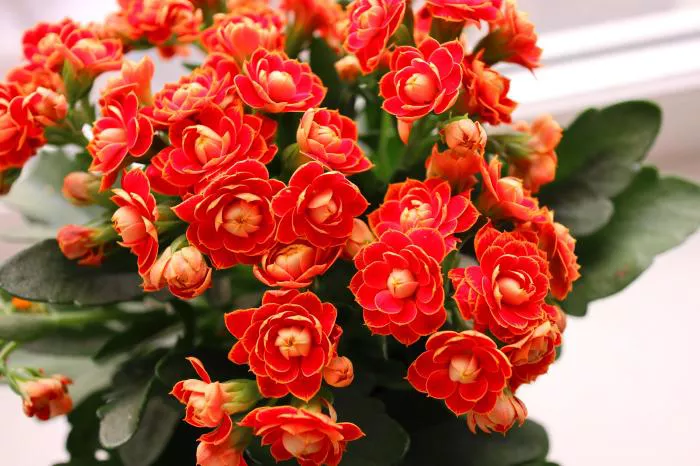Kalanchoe flowers are among the most vibrant and resilient plants in the world of floriculture. Known for their thick, fleshy leaves and beautiful, often brightly colored flowers, kalanchoe is more than just a decorative plant. It carries with it a rich symbolism that resonates across various cultures. This article delves into the meaning and significance of the kalanchoe flower, its origins, and the symbolism it holds in different contexts.
Origin of the Kalanchoe Flower
The kalanchoe plant is native to Madagascar, but it can now be found in many parts of the world. It belongs to the Crassulaceae family and is known for its ability to thrive in dry and hot conditions. Its succulent nature allows it to store water in its leaves, making it incredibly resilient.
Kalanchoe is not just known for its beauty; it has been a part of many traditional practices. In ancient cultures, it was admired for its ability to survive under tough conditions, symbolizing endurance and resilience. The flower’s appearance also plays a role in its symbolism, as its unique clusters of small, colorful blooms create a sense of vitality and energy.
Kalanchoe Flower Symbolism
The kalanchoe flower has various meanings depending on the culture and the context in which it is given. It is often associated with positive traits such as persistence, strength, and the ability to thrive against adversity. The plant’s nature to bloom year after year despite difficult conditions has led it to be seen as a symbol of longevity and the ability to overcome challenges.
In some cultures, kalanchoe flowers are also viewed as a representation of happiness and good fortune. Its bright, cheery colors—ranging from red to pink, yellow, and orange—are seen as omens of joy and success. These colorful blooms are often given during celebrations or important events to convey wishes of prosperity and health.
Kalanchoe as a Gift
Kalanchoe flowers are a popular choice for gift-giving due to their vibrant colors and meaningful symbolism. Whether it is given to celebrate a birthday, an anniversary, or a housewarming, the kalanchoe can express a variety of emotions. The flower’s resilience and beauty make it an ideal gift for someone who has endured a challenging time or is embarking on a new journey.
Red kalanchoe flowers, in particular, are seen as symbols of passion and love. They are often given to someone close, such as a partner or family member, as an expression of deep affection. Yellow kalanchoe flowers symbolize friendship, warmth, and happiness, making them an ideal gift for close friends. Meanwhile, pink kalanchoe flowers are seen as symbols of gratitude and appreciation, often given to someone to thank them for their kindness or support.
Caring for Kalanchoe
One of the reasons why kalanchoe flowers are so symbolic of resilience is because they are relatively easy to care for. Their ability to thrive in dry conditions is a testament to their strength. To grow kalanchoe successfully, it’s important to provide them with well-draining soil and ensure they receive enough sunlight. A location with bright, indirect sunlight is ideal for these plants.
Kalanchoe plants should be watered thoroughly but infrequently. Overwatering can lead to root rot, so it’s essential to allow the soil to dry out between waterings. In colder months, kalanchoe should be kept in a warmer, drier environment. The plant can bloom year after year if cared for properly, making it a lasting symbol of vitality.
Cultural Significance of Kalanchoe
In many cultures, flowers are often associated with specific meanings and emotions. The kalanchoe, in particular, has been seen in various cultural contexts as a symbol of perseverance, love, and well-being. In Chinese culture, for example, kalanchoe flowers are believed to bring good fortune and are often displayed in homes or businesses to attract prosperity.
Similarly, in Western cultures, kalanchoe’s symbolism aligns with notions of strength and resilience. It is commonly used in bouquets for individuals who are going through tough times or recovering from illness, as a gesture of hope and encouragement.
Kalanchoe and Feng Shui
In Feng Shui, the practice of arranging your environment to promote positive energy, the kalanchoe plant holds significant importance. It is thought to bring positive energy and good fortune into the home. The plant’s ability to thrive even in tough conditions makes it a symbol of resilience and the overcoming of obstacles. As such, it is often placed in areas of the home where it can represent prosperity, such as near the front door or in living areas.
Kalanchoe and Healing Properties
Beyond its aesthetic appeal, kalanchoe has also been used for its medicinal properties in certain cultures. In traditional medicine, various parts of the kalanchoe plant have been used to treat a range of ailments, including digestive issues and skin problems. While modern medicine does not widely support its medicinal use, the flower continues to be cherished for its healing symbolism and ability to thrive despite harsh conditions.
Conclusion: The Timeless Meaning of Kalanchoe
The kalanchoe flower is not just a beautiful plant; it carries a deep and meaningful symbolism. From its vibrant colors to its resilience, kalanchoe represents strength, perseverance, and positivity. Whether given as a gift or grown in the home, this flower embodies the enduring nature of life and the beauty that can emerge even from adversity.
Whether you are seeking a symbol of love, friendship, or strength, the kalanchoe flower offers a meaningful and lasting gesture. Its striking blooms and simple care requirements make it a wonderful addition to any garden or home, bringing joy and symbolic significance into everyday life.
Related topics:


